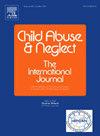Associations between childhood abuse, exposure to domestic violence, and the risk of later violent revictimization in Australia
IF 3.4
2区 心理学
Q1 FAMILY STUDIES
引用次数: 0
Abstract
Background
Childhood abuse and domestic violence exposure are pervasive and linked to many adverse outcomes, including revictimization across the lifespan. Few studies examine the associations between types and combinations of childhood abuse and later revictimization using large representative samples of the general population, especially in the Australian context.
Objective
To examine the associations between childhood physical abuse, sexual abuse, and exposure to domestic violence before 15 years of age and lifetime physical and sexual violence revictimization since 15 years of age.
Participants and setting
Secondary analysis of the Australian Bureau of Statistics 2016 Personal Safety Survey, which collected cross-sectional information on experiences of violence among 21,242 community-dwelling adult men and women.
Methods
Regression analyses to determine whether experiences of childhood abuse and domestic violence were associated with lifetime physical and/or sexual revictimization, controlling for demographic, socio-economic and area-level characteristics.
Results
All three types of childhood abuse/domestic violence exposure, occurring alone or in combination, were associated with higher odds of lifetime physical and/or sexual revictimization in adjusted models; associations were generally strongest for those who experienced multiple types. Men generally reported higher rates of physical revictimization while women reported higher rates of sexual revictimization; however, sex differences varied according to the types of childhood abuse/domestic violence experienced.
Conclusions
Findings add nuance to the understanding of associations between childhood abuse, domestic violence exposure, and later revictimization in a large Australian sample. Preventing children's experiences of abuse and violence, and intervening early to mitigate harms, may help to reduce violence across the lifespan.
儿童期虐待、暴露于家庭暴力和后来再次遭受暴力侵害的风险之间的联系
童年虐待和家庭暴力是普遍存在的,并与许多不良后果有关,包括在整个生命周期中再次受害。很少有研究使用大量具有代表性的普通人群样本,特别是在澳大利亚的背景下,研究儿童虐待的类型和组合与后来再次受害之间的联系。目的探讨15岁前儿童身体虐待、性虐待和家庭暴力暴露与15岁后终生身体暴力和性暴力再受害之间的关系。参与者和背景对澳大利亚统计局2016年个人安全调查的二次分析,该调查收集了21242名社区成年男性和女性的暴力经历的横截面信息。方法通过回归分析确定童年虐待和家庭暴力经历是否与终生身体和/或性再受害相关,控制人口统计学、社会经济和地区水平特征。结果在调整后的模型中,所有三种类型的儿童虐待/家庭暴力暴露,无论是单独发生还是联合发生,都与终生身体和/或性再受害的较高几率相关;对于那些经历过多种类型的人来说,联系通常是最强的。一般来说,男性报告的身体再受害率更高,而女性报告的性再受害率更高;然而,根据所经历的童年虐待/家庭暴力的类型,性别差异有所不同。结论:在澳大利亚的一个大样本中,研究结果增加了对童年虐待、家庭暴力暴露和后来再次受害之间关系的理解的细微差别。防止儿童遭受虐待和暴力,并及早干预以减轻伤害,可能有助于减少整个生命周期中的暴力。
本文章由计算机程序翻译,如有差异,请以英文原文为准。
求助全文
约1分钟内获得全文
求助全文
来源期刊

Child Abuse & Neglect
Multiple-
CiteScore
7.40
自引率
10.40%
发文量
397
期刊介绍:
Official Publication of the International Society for Prevention of Child Abuse and Neglect. Child Abuse & Neglect The International Journal, provides an international, multidisciplinary forum on all aspects of child abuse and neglect, with special emphasis on prevention and treatment; the scope extends further to all those aspects of life which either favor or hinder child development. While contributions will primarily be from the fields of psychology, psychiatry, social work, medicine, nursing, law enforcement, legislature, education, and anthropology, the Journal encourages the concerned lay individual and child-oriented advocate organizations to contribute.
 求助内容:
求助内容: 应助结果提醒方式:
应助结果提醒方式:


